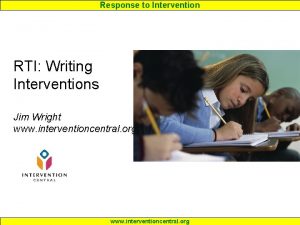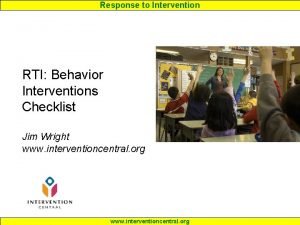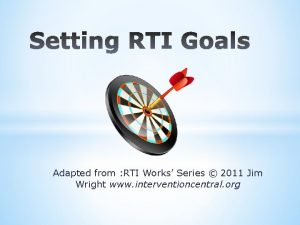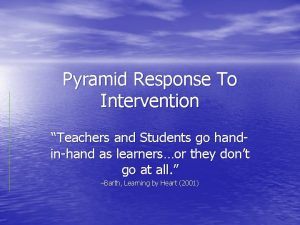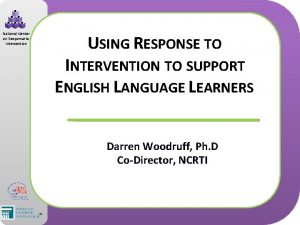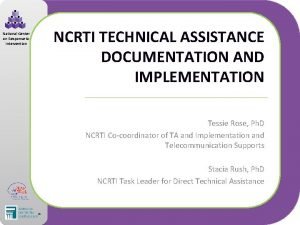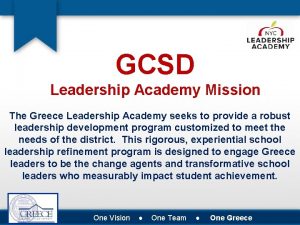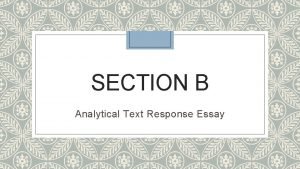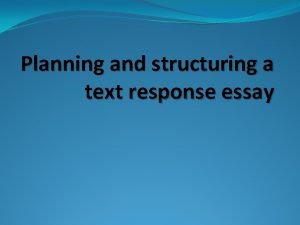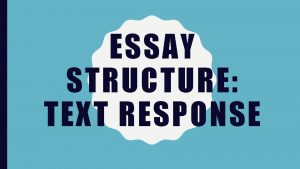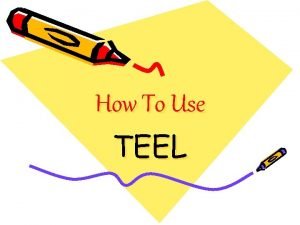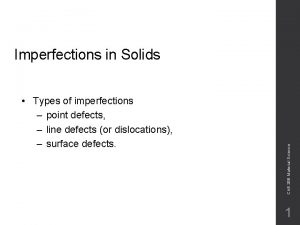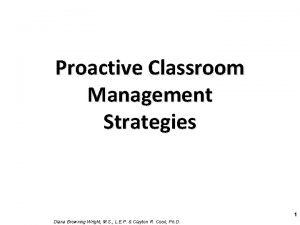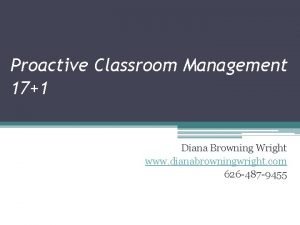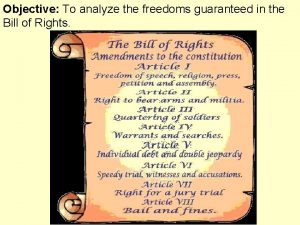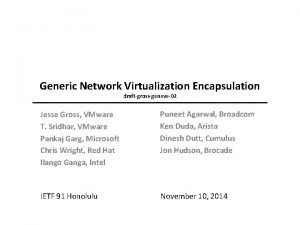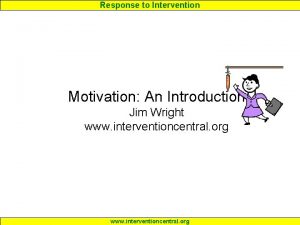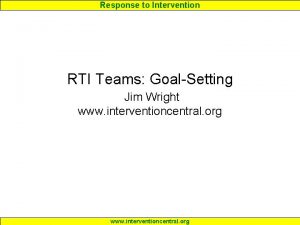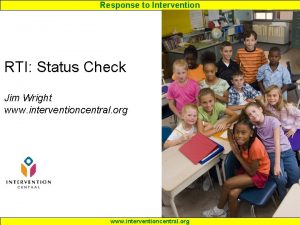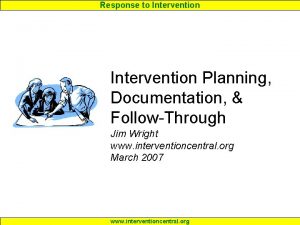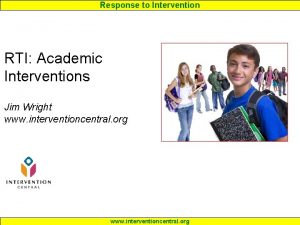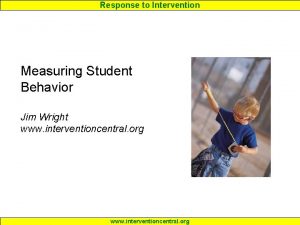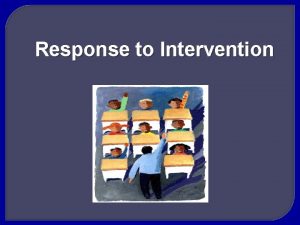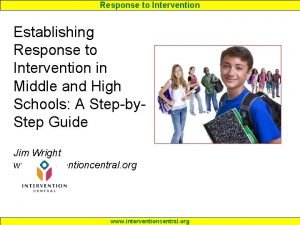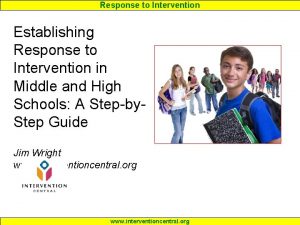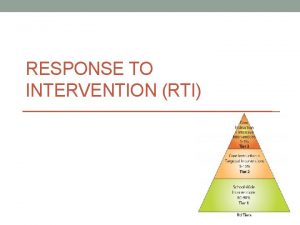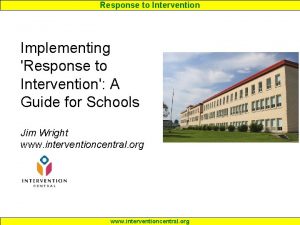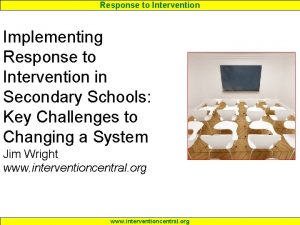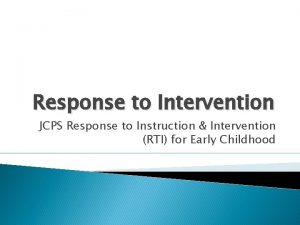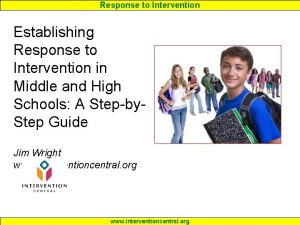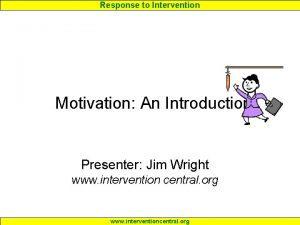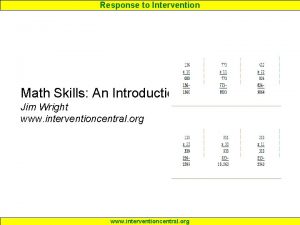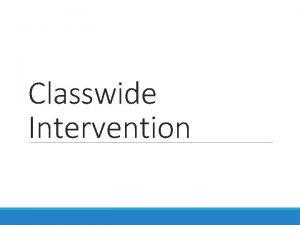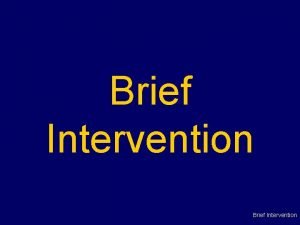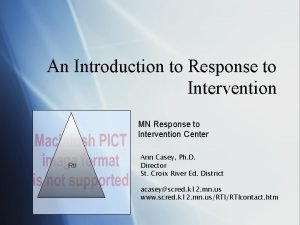Response to Intervention An Introduction Jim Wright www



























- Slides: 27

Response to Intervention: An Introduction Jim Wright www. interventioncentral. org

Response to Intervention Central www. interventioncentral. o rg www. interventioncentral. org

Response to Intervention www. interventioncentral. org

Response to Intervention Access PPTs and other materials from this workshop at: http: //www. interventioncentral. org/hi_do e www. interventioncentral. org

Response to Intervention Professional Development Agenda Day 1: Response to Intervention: An Introduction. Day 1: Tier 1: Universal Instruction & Classroom Intervention. Day 1: Tier 2: Supplemental Intervention: Standard -Treatment Protocol. Day 1: Tier 3: Intensive Intervention: Problem. Solving Protocol. Day 2: Academic & Behavioral Interventions. Day 2: Schoolwide Screening Tools. Day 2: RTI Systems-Level Change. Day 2: RTI Action Plan Development. www. interventioncentral. org

Response to Intervention: An Introduction An Overview of RTI. What is the RTI model and what assumptions support it? www. interventioncentral. org 7

Response to Intervention School Instructional Time: The Irreplaceable Resource “In the average school system, there are 330 minutes in the instructional day, 1, 650 minutes in the instructional week, and 56, 700 minutes in the instructional year. Except in unusual circumstances, these are the only minutes we have to provide effective services for students. The number of years we have to apply these minutes is fixed. Therefore, each minute counts and schools cannot afford to support inefficient models of service Source: Batsche, G. M. , Castillo, J. M. , Dixon, D. N. , & Forde, S. (2008). Best practices in problem analysis. In A. Thomas & J. Grimes (Eds. ), Best practices in school psychology V (pp. 177 -193). delivery. ” www. interventioncentral. org 8

Response to Intervention RTI Assumption: Struggling Students Are ‘Typical’ Until Proven Otherwise… RTI logic assumes that: – A student who begins to struggle in general education is typical, and that – It is general education’s responsibility to find the instructional strategies that will unlock the student’s learning potential Only when the student shows through welldocumented interventions that he or she has ‘failed to respond to intervention’ does RTI begin to investigate the possibility that the student may have a learning disability or other special education condition. www. interventioncentral. org 9

Response to Intervention Essential Elements of RTI (Fairbanks, Sugai, Guardino, & Lathrop, 2007) 1. A “continuum of evidence-based services available to all students" that range from universal to highly individualized & intensive 2. “Decision points to determine if students are performing significantly below the level of their peers in academic and social behavior domains" 3. “Ongoing monitoring of student progress" 4. “Employment of more intensive or different interventions when students do not improve in response" to lesser interventions 5. “Evaluation for special education services if students do not respond to intervention Source: Fairbanks, S. , Sugai, G. , Guardino, S. , & Lathrop, M. (2007). Response to intervention: instruction" Examining classroom behavior support in second grade. Exceptional Children, 73, p. 289. www. interventioncentral. org 10

Response to Intervention RTI Interventions: Standard-Treatment vs. Problem. Solving There are two different vehicles that schools can use to deliver RTI interventions: Standard-Protocol. Programs based on scientifically valid instructional practices (‘standard protocol’) are created to address frequent student referral concerns. These services are provided outside of the classroom. An elementary school, for example, may put into place the HELPS tutoring program (www. helpsprogram. org: targeting reading fluency) to address large numbers of Tier 2 students with delayed reading fluency skills. An advantage of the standard-protocol approach is that it is efficient and consistent: groups of students can be put into these group interventions to receive a highly standardized intervention. However, standard group intervention protocols often cannot be individualized easily to accommodate a specific student’s unique needs. Problem-solving. When intervention plans are developed to match the profile of a particular student’s strengths and weaknesses, this approach is called the ‘problem-solving’ model. The problem-solving approach is openended and investigative—and addresses the ‘whole child’. A plus of the www. interventioncentral. org 11

Response to Intervention RTI ‘Pyramid of Interventions’ Tier 3 Tier 2 Tier 1 Tier 3: Intensive interventions. Students who are ‘non-responders’ to Tiers 1 & 2 are referred to the RTI Team for more intensive interventions. Tier 2 Individualized interventions. Subset of students receive interventions targeting specific needs. Tier 1: Universal interventions. Available to all students in a classroom or school. Can consist of whole-group or individual www. interventioncentral. org 12

Response to Intervention Levels of Intervention: Tiers 1, 2 & 3 Tier 1: Universal 100% Tier 2: Individualized ~15% www. interventioncentral. org Tier 3: Intensive ~ 1 -5%

Response to Intervention Avg Classroom Academic Performance Level Discrepancy 1: Skill Gap (Current Performance Level) Target Student Discrepancy 2: Gap in Rate of Learning (‘Slope of Improvement’) ‘Dual-Discrepancy’: RTI Model of Learning Disability (Fuchs 2003) www. interventioncentral. org 14

Response to Intervention: An Introduction RTI & Linkages to Other Initiatives. How does RTI support other school initiatives, such as adoption of the Common Core Standards? www. interventioncentral. org 15

Response to Intervention Race to the Top (RTT) is a initiative funded through the U. S. Department of Education that provides states with large grants if they agree to revamp their schools' educational practices to include (1) implementation of rigorous academic standards and assessments; (2) implementation of data systems capable of providing educators and parents with relevant, timely information about student academic performance and progress; (3) increased standards of accountability for teachers and school administrators; and (4) focus on intensive interventions to transform low-performing schools. Race to www. interventioncentral. org the Top has had an outsized 16

Response to Intervention Common Core State Standards (CCSS) The Common Core State Standards (CCSS) are sets of K-12 English Language Arts and Mathematics standards introduced in 2010 by two non-governmental organizations: the National Governors Association Center for Best Practices and the Council of Chief State School Officers. The focus of the CCSS is on raising the academic outcomes for all students. The express goal of the CCSS developers has been to encourage states to replace their locally developed, often highly variable, academic standards with these 'national' standards--both to increase the rigor of instruction and to create shared student academic www. interventioncentral. org 17

Response to Intervention Common Core State Standards Initiative http: //www. corestandards. or g/ View the set of Common Core Standards for English Language Arts (including writing) and mathematics being adopted by states Source: National Governors Association across America. Center for Best Practices and Council of Chief State School Officers. (2010). Common Core State Standards for English Language Arts & Literacy in History/Social Studies, Science, and Technical Subjects. . Retrieved on September 23, 2012, from http: //www. corestandards. org/; p. 6. www. interventioncentral. org

Response to Intervention Common Core State Standards: Supporting Different Learners in ELA “The Standards set grade-specific standards but do not define the intervention methods or materials necessary to support students who are well below or well above grade-level expectations. No set of gradespecific standards can fully reflect the great variety in abilities, needs, learning rates, and achievement levels of students in any given classroom. ” Source: National Governors Association Center for Best Practices and Council of Chief State School Officers. (2010). Common Core State Standards for English Language Arts & Literacy in History/Social Studies, Science, and Technical Subjects. . Retrieved on September 23, 2012, from http: //www. corestandards. org/; p. 6. www. interventioncentral. org 19

Response to Intervention Common Core State Standards: Supporting Different Learners in ELA “…It is also beyond the scope of the Standards to define the full range of supports appropriate for English language learners and for students with special needs. At the same time, all students must have the opportunity to learn and meet the same high standards if they are to access the knowledge and skills necessary in their post–high school lives. ” Source: National Governors Association Center for Best Practices and Council of Chief State School Officers. (2010). Common Core State Standards for English Language Arts & Literacy in History/Social Studies, Science, and Technical Subjects. . Retrieved on September 23, 2012, from http: //www. corestandards. org/; p. 6. www. interventioncentral. org 20

Response to Intervention (RTI) is a blue-print that schools can implement to proactively identify students who struggle with academic and/or behavioral deficits and provide them with academic and behavioral intervention support. RTI divides school support resources into 3 progressively more intensive levels--or 'tiers'--of intervention. RTI first gained national recognition when written into congressional legislation, the Individuals with Disabilities Education Improvement Act (IDEIA) of 2004. Because the focus of RTI is on the underperforming learner, schools can use this www. interventioncentral. org 21

Response to Intervention: An Introduction RTI in Middle and High School. What are particular challenges that face RTI at the middle and high school level? www. interventioncentral. org 22

Response to Intervention School Dropout as a Process, Not an Event “It is increasingly accepted that dropout is best conceptualized as a long-term process, not an instantaneous event; however, most interventions are administered at a middle or high school level after problems are severe. ” Source: Jimerson, S. , Reschly, A. L. , & Hess, R. (2008). Best practices in increasing the likelihood of school completion. In A. Thomas & J. Grimes (Eds). Best Practices in School Psychology - 5 th Ed (pp. 1085 -1097). Bethesda, MD: National Association of School Psychologists. . p. 1090 www. interventioncentral. org 23

Response to Intervention Student Motivation & The Need for Intervention “A common response to students who struggle in sixth grade is to wait and hope they grow out of it or adapt, to attribute early struggles to the natural commotion of early adolescence and to temporary difficulties in adapting to new organizational structures of schooling, more challenging curricula and assessment, and less personalized attention. Our evidence clearly indicates that, at least in high-poverty urban schools, sixth graders who are missing 20% or more of the days, exhibiting poor behavior, or failing math or English do not recover. On the contrary, they drop out. This says that early intervention is Source: Balfanz, R. , Herzog, productive L. , Mac. Iver, D. J. (2007). Preventing student disengagement and keeping not only but absolutely essential. ” students on the graduation path in urban middle grades schools: Early identification and effective interventions. Educational Psychologist, 42, 223– 235. . www. interventioncentral. org 24

Response to Intervention What Are the ‘Early Warning Flags’ of Student Drop-Out? • • A sample of 13, 000 students in Philadelphia were tracked for 8 years. These early warning indicators were found to predict student dropout in the sixth-grade year: Failure in English Failure in math Missing at least 20% of school days Receiving an ‘unsatisfactory’ behavior rating from at least one teacher Source: Balfanz, R. , Herzog, L. , Mac. Iver, D. J. (2007). Preventing student disengagement and keeping students on the graduation path in urban middle grades schools: Early identification and effective interventions. Educational Psychologist, 42, 223– 235. . www. interventioncentral. org 25

Response to Intervention What is the Predictive Power of These Early Warning Flags? Number of ‘Early Warning Flags’ in Student Record Probability That Student Would Graduate None 56% 1 36% 2 21% 3 13% 4 7% Source: Balfanz, R. , Herzog, L. , Mac. Iver, D. J. (2007). Preventing student disengagement and keeping students on the graduation path in urban middle grades schools: Early identification and effective interventions. Educational Psychologist, 42, 223– 235. . www. interventioncentral. org 26

Response to Intervention Secondary Students: Unique Challenges… Struggling learners in middle and high school may: • Have significant deficits in basic academic skills • Lack higher-level problem-solving strategies and concepts • Present with issues of school motivation • Show social/emotional concerns that interfere with academics • Have difficulty with attendance • Are often in a process of disengaging from learning even as adults in school expect that those studentswww. interventioncentral. org will move toward being ‘self- 27

Response to Intervention Activity: What are Your RTI Questions? • In your groups, discuss what RTI questions you hope to have answered in this 2 -day workshop. • Be prepared to report out! www. interventioncentral. org 28
 Jim wright intervention central
Jim wright intervention central Writing interventions for rti
Writing interventions for rti Dr. jim wright
Dr. jim wright Rti checklist
Rti checklist Jim wright rti
Jim wright rti Response to intervention pyramid
Response to intervention pyramid National center for response to intervention
National center for response to intervention National center on response to intervention
National center on response to intervention Simplifying response to intervention
Simplifying response to intervention Natural response and forced response
Natural response and forced response What is natural response
What is natural response A subsequent
A subsequent Text response essay introduction example
Text response essay introduction example How to write a text response essay introduction
How to write a text response essay introduction Conclusion text response essay
Conclusion text response essay Summary response essay
Summary response essay Teel paragraph
Teel paragraph Slip defect
Slip defect Erik olin wright sınıf kuramı
Erik olin wright sınıf kuramı C wright mills
C wright mills Diana browning wright
Diana browning wright Diana browning wright
Diana browning wright Oração de joe wright
Oração de joe wright Oyez ingraham v wright
Oyez ingraham v wright Walt wright checkerboarding
Walt wright checkerboarding Haematology consultants sheffield
Haematology consultants sheffield Generic network virtualization encapsulation
Generic network virtualization encapsulation Falling water maison
Falling water maison

